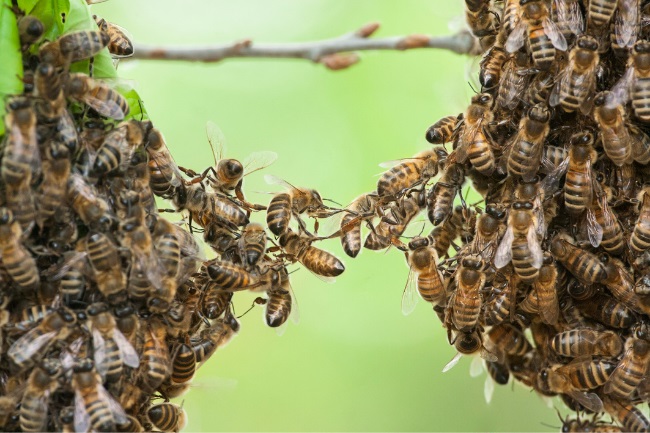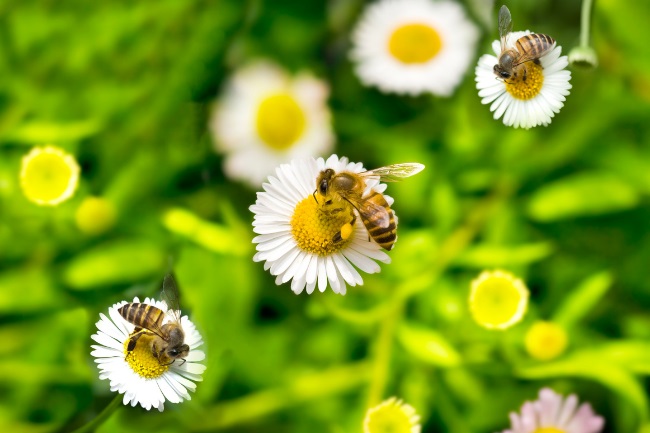Bees are important to plants because they act as pollinators. They move between flowers sipping nectar and accidentally spreading pollen from one plant to another. This facilitated the development of seeds and fruits.
Contents
What is a pollinator?

We hear so much about the importance of pollinators and their value to life on earth, but what are they? Simply put, a pollinator is an animal that moves pollen between two plants, usually by accident as they are feeding. Many different types of animals can be pollinators, from bats to lizards and even to monkeys.
| Pollination Method | Description |
|---|---|
| Bee Pollination | Bees actively visit flowers to collect nectar and pollen, transferring pollen between flowers. |
| Wind Pollination | Pollen is carried by the wind, and it can be less targeted and less efficient than bee pollination. |
| Animal Pollination | Other animals like butterflies, hummingbirds, and bats can also be pollinators, but bees are among the most efficient. |
| Self-pollination | Some plants can self-pollinate, but cross-pollination by bees increases genetic diversity. |
However, our most effective pollinators are primarily insects. Indeed it is believed that the evolution of flowers is closely linked to the evolution of insects, with many species having become closely adapted to each over time. Many types of fig, for example, can only be pollinated by one species of wasp. If one were to disappear, so would the other.
Why are bees such good pollinators?
Bees are often praised as being excellent pollinators, yet they aren’t the only insects to pollinate plants. Wasps, ants, butterflies and even beetles are all busy pollinating our countryside too, so why do bees get all the praise?
1. They are fluffy
One of the reasons bees make such good pollinators is that they are fluffy. Bees species are covered in varying amounts of hair, from the extremely fluffy bumblebees to the sparsely covered furrow bees. These hairs are excellent for accidentally picking up particles of pollen. As the bee visits the next flower, some of that pollen will fall off, helping to pollinate the plant.
2. They can fly
Bees ability to fly means they can visit a large number of flowers and travel great distances. This helps pollen to get scattered across lots of different plants. As the flowers immediately surrounding each other are more likely to be related, it’s best if their pollen can be exchanged with others further away to increase genetic diversity.
3. They feed on nectar and pollen
One of the main reasons bees are such good pollinators is that they visit flowers to feed on the pollen and nectar within them. This means they’re busy bumbling around the flowerhead anyway, picking up pollen as they go.
4. They can be fussy
Some bees will feed on anything they can find; however, many species have specific flowers they will visit. This is great for the flowers because it means they are more likely to get pollinated. If a bee visits a daisy and then a daffodil, there’s no chance of any cross-pollination, whereas a bee that only visits daisies will be more efficient.
Are all bees equal pollinators?

There are over 20,000 species of bees across the globe, and the fact is that not all of them are equally good at pollination. We often talk about the honey bee as being the king of pollination, but actually, the honey bee isn’t the best pollinator in the bee family. So why is this?
Honey bees are famous for their honey production. One of the things that makes them so great at making honey is how efficient they are at collecting pollen. What makes them so efficient is that they have pollen baskets on their back legs. These allow them to secure the pollen in place so that it doesn’t fall out. You’ll notice these fastidious little creatures carefully brushing pollen from the rest of their fur into their pollen baskets.
Other bee species lack these handy little receptacles. Some species like leafcutter bees have long hairs on the underside of their abdomen, where they collect their pollen. This makes them look somewhat like they’ve been dipped in the golden dust-like particles. Long-horn bees have long hairs on their back legs, which they can attach their pollen to.
| Benefits | Description |
|---|---|
| Increased Fruit Set | Bee pollination results in higher fruit production for many plants, leading to better crop yields. |
| Genetic Diversity | Cross-pollination by bees introduces genetic variation in plants, enhancing their resilience and adaptability. |
| Enhanced Reproduction | Pollination helps plants produce seeds, ensuring their survival and contributing to ecosystem balance. |
| Improved Floral Diversity | Bees visit various flowers, promoting the diversity of plant species and supporting biodiversity. |
| Ecological Services | Bees’ role as pollinators is essential for maintaining healthy ecosystems and supporting wildlife populations. |
It’s actually the messiest bee species that can be the best at pollinating, as they lose the most pollen as they move from one flower to another. It’s thought that one red mason bee can be equivalent to 120 honey bees in terms of its ability to pollinate flowers.
Aside from their over tidiness, honey bees are also generalist feeders, meaning they are less likely to move between the same species of flowers. They are also very efficient feeders. Meaning that they prefer to visit one patch of flowers over and over again, rather than travelling further away to find new areas, so they spread their pollen less widely.
This isn’t to say honey bees aren’t important pollinators, but just that many other species of bees are even better. However, some bees barely pollinate at all. Cuckoo bumblebees don’t collect pollen, as they lay their eggs in the nest of other species of bumblebee, meaning they don’t need to collect pollen for their young. They do still visit flowers to drink nectar themselves, so they still do a little pollinating, despite their laziness.
Also read: What do Bumblebees Eat and Drink? (Habits Explained)
Why are bees essential to human life?

Bees are essential for human life because plants are essential, and many of them rely on insects for pollination. It’s thought potentially 80% use insects for this task. Many of our crops to rely on bees for pollination, from kiwis to almonds to watermelons. However, most of our common arable crops, such as wheat, rice and barley are actually wind pollinated and do not need bees at all.
| Plant Type | Examples of Bee-Pollinated Plants |
|---|---|
| Fruits | Apples, strawberries, blueberries, cherries, oranges |
| Vegetables | Tomatoes, zucchinis, cucumbers, peppers, pumpkins |
| Nuts | Almonds, cashews, pistachios, walnuts |
| Seeds | Sunflowers, canola, sesame, flaxseeds |
| Flowers | Lavender, roses, lilies, daisies, sunflowers |
Yet, a world without bees would still be a much starker and less vibrant one. From honey to poppy seeds, from meadows to wedding bouquets, from Monet’s lilies to Van Gogh’s sunflowers, we get a great deal from our buzzy little friends.
What can we do to help bees?
Bees are important for so many reasons, but not least because they have just as much right to this planet as the rest of us. Many of the changes humans have made to the landscape have been detrimental to bee species, such as the creation of vast urban areas or the loss of flowers in our countryside. So to give them a little boost by doing things to help these little insects.
- You can make sure you plant bee-friendly plants in your garden or even just on your balcony.
- By avoiding pesticides, you can ensure you don’t accidentally harm bees by applying these toxins to areas they are using.
- By buying food from organic or wildlife-friendly farms, you can help create a more vibrant farming landscape.
- Leave areas of your lawn unmown to allow plants to flower.
- Remove areas of unnecessary concrete or fake grass in favour of plants and flowers.
Also read: Is Beekeeping Cruel? Does it Harm Bees?
Bee kind
Bees aren’t the only insects we rely on; from earthworms to dung beetles, many insects perform vital work without which our world would be a very different place. Often we think of them only as unpleasant or scary creatures, but they are the building blocks of our home, and therefore our lives. So make a little space for them in your world. With all the hard work they’re doing, they certainly deserve it.

